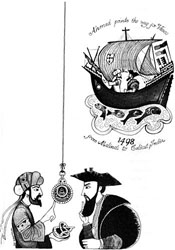|
It will be remembered too that in the fifteenth century Vasco de Gama, exploring the east coast of Africa near Malindi, was guided by an Arab pilot who used maps never before known to Europeans. The pilot's name was Ahmed ibn Majid.39 Horticulture The Arabs loved the land, for in the earth and the water they saw the source of life and the greatest of God's gifts. They were guided by the words attributed to the Prophet: "Whoever bringeth the dead land to life . . . for him is reward therein." They were pioneers in botany, and in the twelfth century an out�standing reference work, Al-Filahat by ibn-Al-Awam, described more than five hundred different plants and methods of grafting, soil conditioning and curing of diseased vines and trees. 40 The Arab contributions to food production are legion. They were able to graft a single vine so that it would bear grapes in different colors, and their vineyards produced the future wine industries of Europe.41 Peach, apricot and loquat trees were re-planted in southern Europe by Arab soldiers. The hardy olive was encouraged to grow in the sandy soil of Greece, Spain and Sicily to begin the olive and oil industries. From India they introduced the cultivation of sugar, and from Egypt they brought cotton to European markets. "May there always be coffee at your house," was their expression wishing prosperity and the joy of hospitality for their friends. Coffee was "Qahwah." that which gives strength, and derivatives of that name are used today in almost every country of the world. They also perfected the storage of soft fruits to be eaten fresh throughout the year.42
Arab horticulture gave the world the fragrant flowers and herbs from which perfumes were extracted. Their walled gardens were for the pleasure of the senses -- a pine tree standing green and aromatic in the heart of a garden scented with jasmine; a fountain or artificial pool to delight the eye admidst lavender and laurel; a special rose garden blooming in riotous color, the roots injected with saffron to produce yellow, and indigo to produce blue flowers; vines and trees injected with perfumes in the autumn flooding the air with fragrance in the spring; a weeping willow dipping gracefully into the middle of a clear lake; arbours and pergolas constructed where streams of water could bubble through them, cooling the air and giving relief from the heat of the desert. Mimosa and wild cherry lavished color against stone walls, and cypress grew tall, close, and straight, bordering alleyways to obliterate from view all that was not pleasing to the sight. They were not quick to cut down barren trees. "Don't do that," one would say to the other, loudly, within earshot of the ailing tree. "Why not? It is not bearing fruit." "Yes, but it might bear next year. Leave it, let us see;" and the tree, as though realizing it had been given a second chance, might bear an overabundance of fruit the following spring. Bulb flowers were already in a highly hydridized, cultivated state when the Crusaders carried them home from Palestine to western Europe toward the end of the centuries of Arab power. Rice, sesame, melons and shallots, as well as dates, figs, orange, lemon, and other citrus fruits, pepper, ginger, and cloves were introduced into the European cuisine via the Crusades and the trade caravans of Eastern merchants. |
